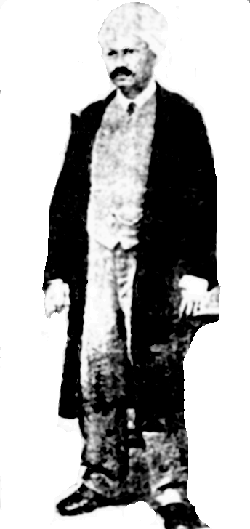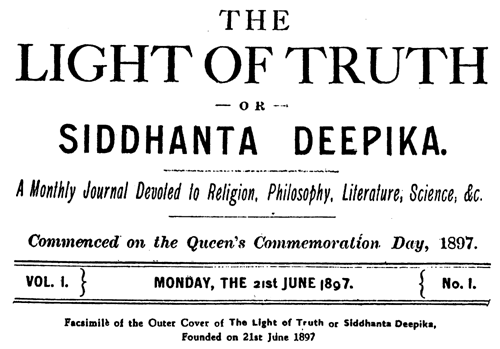|
One Hundred
Tamils
of the 20th Century
J M Nallaswami Pillai
1864-1920
V. S. Sundaram
in
News Today, 19 February, 2008
 In
the last quarter of the 19th century, two great Tamil
Scholars and Savants created a Saivait Revolution in
Madras Presidency by reviving and resurrecting Saiva
Siddhanta System and Philosophy. One of them was
Arumuga
Navalar (1822-1879) from Jaffna in Sri Lanka. The
other Scholar was J.M. Nallaswami Pillai
(1864-1920). In
the last quarter of the 19th century, two great Tamil
Scholars and Savants created a Saivait Revolution in
Madras Presidency by reviving and resurrecting Saiva
Siddhanta System and Philosophy. One of them was
Arumuga
Navalar (1822-1879) from Jaffna in Sri Lanka. The
other Scholar was J.M. Nallaswami Pillai
(1864-1920).
J M Nallaswami Pillai was a
contemporary of Vedanayagam
Pillai (1826-1889) and Dr U V Swaminatha
Iyer (1855-1941). He was a multi-faceted genius
and his wide ranging literary activities as a
powerful writer, translator and propagandist of Saiva
Siddhanta were mainly responsible for re-kindling the
revival of academic interest in Saiva Siddhanta in
Europe and America in the first decade of 20th
century. He was acknowledged by all his
contemporaries as an outstanding authority on the
philosophical works known as Saiva Siddhanta Sastras.
By his translations of nine (9) of the fourteen (14)
books coming under this category and by his
authoritative commentaries and essays on the Saiva
Siddhanta he become, probably, the most voluminous
writer on that philosophical system in the English
language.
Nallaswami Pillai was born in a
respectable Vellala Family at Trichirappalli on 24
November, 1864. He came from a very influential
family, many of whose ancestors had held high
official positions under the Carnatic Nawabs. His
father was Manickam Pillai who was employed as a
Clark in the District Police Office at
Tiruchirappalli. He studied at SPG High School in
Tiruchirappalli, passing the Matriculation
Examination with Distinction in 1879. He then went to
SPG College, Tiruchirappali for his Intermediate
College Education.
His College Principal Mr. C.W.
Pearco, an Englishman, was the first recognize the
genius of Nallaswami Pillai and described him as 'a
radical student'. He passed his Intermediate
Examination in First Class obtaining the First Rank
in 1881. Soon thereafter he joined the Presidency
College, Madras in 1881 and passed his B.A. with
distinction in 1884. What is significant is that he
took up Logic and Philosophy as his special subjects
in his BA Class and this academic training turned out
to be a great asset in his activities as a
Philosopher and Religious Savant in his later years.
Two distinguished Professors of Presidency College Dr
D Duncan and Mr Bilderbeck rated Nallaswami Pillai as
'An outstanding Scholar with an incisive mind with
concern for minuteness and exactness'.
In 1884, he was married to Lakshmi
Ammal who was the daughter of one of his relations
called Parasurama Pillai of Tiruchirappali. He led
the ideal life of a Grihasta.
After qualifying for Law from the
Madras Law College, he enrolled himself as a High
Court 'Vakil' in 1887 and worked as a junior under
Sir S. Subramania Aiyar, at Madurai. Sir S.
Subramania Aiyar was a leader of the Madurai Bar
then. Apart from devoting himself to his legal work
and public affairs, Nallaswami Pillai started
concentrating on the study and discussion of
Religious and Philosophical Subject, particularly
Saiva Siddhanta.
Nallaswami Pillai was elected as
Member of the Madurai Municipal Council. His
brilliance as a Lawyer was noticed by Mr. Ross,
I.C.S. who was then the District and Sessions Judge
at Madurai. On his recommendation, Nallaswami was
recruited to the Judiciary in 1893 as District
Munsif, in which capacity he served for 20 years in
various places. Though he became a District Munsif
early in his life, he was not one of those routine
beings who get lost in a job without regard for the
finer instincts of a nobler and detached life. He
early in his life he had developed a proper
perspective on all aspects of leading a meaningful
life with a balanced sense of proportion.
Nallaswami Pillai resigned from his
Judicial post and reverted to the Bar in Madurai in
1912. He continued his practise as a Lawyer at
Madurai till his death in 1920 at the comparatively
early age of 56.
Nallaswami Pillai is best remembered
as a Tamil Savant, whose writings on the Saiva
Siddhanta Philosophy have an enduring value. He came
early under the influence of the writings of Arumuga
Navalar of Jaffna and Somasundara Nayagar of Madras,
two of the most powerful champions of Saiva
revivalism of the last century.
In 1895 Nallaswami Pillai published
his English translation and exposition of Sivagnana
Bodham of Meikanda Devar, a short work of twelve
sutras, with explanatory prose and some illustrative
stanzas. The Sivaghana Bodham is considered to be the
most authentic Saiva Siddhanta scripture for which a
most brilliant and authoritative commentary was
written by Sivagnana Swamigal in the 18th century. It
is known as the 'Mapadiyam' (Tamil form of
Mahabhashyam). Nallaswami Pillai's translation and
exposition are based on this commentary. In the
sixties of the 19th century an English translation of
this work was published by Rev. Hoisington but it did
not attract as much notice as that of Nallaswami
Pillai's which was better in every respect.
Nallaswami Pillai's English
translation of Sivagnana Bodam in 1895, attracted
worldwide attention in the West. In this book he
wrote:
'Sivagnana Bodham is a unique book
of unrivalled compression of words and ideas
alike.Its terseness of diction and brevity of
expression will baffle the powers of exposition and
beggar the attempts at translation by even the
biggest of Tamil Pundits.'
In June 1897, in commemoration of the
Diamond Jubilee of the accession of the Queen Empress
Victoria to the British throne, Nallaswami Pillai
started a monthly journal called the SIDDHANTA DIPIKA
OR THE LIGHT OF TRUTH at Madras.

Writing in the first issue on 'OUR
AIMS' he said:
'We have considered it a shame that
we should be coached in our Vedas and Vedanta by
German Professors on the banks of the Rhine in
Europe and that an American from a far off country
should be the first translator of the foremost work
in Tami Philosophy and that an old Oxford Professor
like Dr G U Pope should sit poring over the Tamil
'WORD' and render into English verse. Far from
condemning such noble examples which redound
greatly to the glory of the European, I would say
'Noble examples they! May we follow! Our journal
will devote itself to bring out translations of
rare works in Sanskrit and Tamil, Literary,
Philosophical and Religious, will devote its pages
to a more critical and historical study of Indian
Religious Systems, to develop a taste for and to
induce a proper and more appreciative cultivation
of our Indian Classical and Vernacular Languages
and Literature. Greater attention will be paid to
the language and history of South India and the
Dravidian Philosophy and Religion will find their
best exposition in its pages and in this respect it
is intended to supply a real and absolutely felt
public want.'
Nallaswami Pillai also published
English translations of Tirumular's great poem
Tirumantiram and nine of the Siddhanta works in his
monthly magazine Siddhanta Dipika. They were all
published under his personal guidance for 14 years
from 1897 to 1911 for popularising Tamil Classics and
Saiva Siddhanta Philosophy among the English knowing
public. He wrote many essays on the various aspects
of this system, which were later, collected and
published as a book under the title 'Studies in the
Saiva Siddhanta', which shows his power as a lucid
thinker and forceful and dignified
controversialist.
His magnum opus, however, was his
English translation of the Sivagnana Siddhiyar with a
commentary, which, though based on earlier works was
singularly profound. This appeared in a serial form
for several years in the Siddhanta Dipika and was
later published in a book form in 1913 with a learned
introduction. The author of Sivagnana Sidhiyar was
Arulnandi Sivacharya who was a most learned Vedic and
Agamic Brahmin Scholar of his age. He became a
disciple of the young Vellala saint Meikanda Devar,
considering him to be an illumined soul and set an
example of totally ignoring caste in the religious
and spiritual field, which was followed by the
equally great Umapathy Sivacharya. There had been an
earlier translation of the Sivagnana Siddhiyar by Dr.
Graul, a German scholar but it was only a pioneer
attempt, which was replaced by Nallaswami Pillai's
more accurate and brilliant translation...
In the Convention of Religions held
at Calcutta in 1907 and at Allahabad in 1911, it was
Nallaswami Pillai who was the spokesman for Saivism
and the Siddhanta philosophy and delivered stirring
addresses.
The value of his works was recognised
and their entire copyright was acquired by the
Dharmapuram Mutt, which has published a few of his
works. A collection of all his English writings
including his translations of the religious books, if
brought out in a single well-edited volume, will show
the wide range of his learning, the strength of his
intellect and the tireless and devoted work, which he
did for popularising the Saiva Siddhanta philosophy
and establish his lasting fame as the most well read
and level headed Saiva Siddhanta scholar of his
age.
|